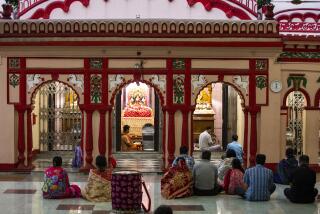Myanmar Muslim Refugees in Bangladesh Poor, Forgotten in Poorest of Nations
- Share via
RAMU, Bangladesh — Thousands of Burmese Muslims are fleeing to Bangladesh each month, swelling one of the world’s largest refugee concentrations in one of the world’s poorest countries.
But neither the refugees--from Arakan, the only Muslim majority province in Myanmar, formerly Burma--nor their hard-pressed hosts have yet managed to alert the world to their plight.
“We thought the issue would come to light someday,” said one official in the small town of Ramu in southeast Bangladesh.
The refugees, members of the Rohingya Muslim community from southwest Myanmar, say they have suffered religious discrimination, repression and denial of fundamental rights at the hands of the government in Yangon, formerly Rangoon.
They said that Bangladeshi people are friendly and even share their meager food supplies.
“But this is no permanent solution,” refugee Fazal Ahmed said. “We need the rest of the world to do something for us, like they are doing for the Afghan refugees in Pakistan.”
According to official figures, more than half a million Rohingyas from Arakan province have crossed into Bangladesh since the 1970s and now live in hills and forests.
They work on fishing trawlers and do menial jobs, including collecting and selling wood to buy rice.
“We have no food for six days because my husband could not get into the jungles due to heavy rain,” said Amina Khatun, 35.
Khatun’s family shares an abandoned school building near Ramu with 33 other families. “I feel very sad for my children. We had a home, crops and plenty of work in Arakan, but here we are almost starving,” she said, weeping.
Bangladeshi villagers said at least 30 Burmese children have died since April from malnutrition and disease.
“More will die soon,” one said, indicating a group of boys and girls with protruding ribs and sunken eyes.
The Rohingyas began arriving in large numbers in 1976 and their number swelled to 300,000 in 1978, forcing Bangladesh’s government to open refugee camps near the border.
Although most of those refugees returned to Myanmar a year later under an agreement reached between the two governments, the numbers have built up again and many have put down roots.
“They have married their children to Bangladeshis, shared their homes and mingled with the locals, thanks to striking physical and linguistic similarities between the two communities,” one police officer said.
But thousands remain in need.
“Tell the world, especially the U.N. High Commissioner for Refugees, that we need emergency aid,” said 50-year-old Ahmed, a refugee for two years.
“We hear they (aid agencies) give so much help to other refugees. Then why should we be excluded?” he pleaded.
“Bangladesh cannot bear all the responsibilities for us,” said another refugee.
Officials said UNHCR and other agencies built some homes for refugees after the 1976 influx but no other help had arrived.
Rohingya women said they preferred to stay in Bangladesh despite hunger and disease.
“In Arakan, the Burmese army, Lunthin (border guards) and their agents would pull down a girl from her bed and rape her in front of her parents,” said Shaheda Khatun, 35.
“Children were not allowed to go to schools, crops were forcibly taken to government warehouses and our men were forced to help build military barracks,” she said.
Leaders of the Rohingya Solidarity Organization said Bangladesh must take up the refugee issue “with adequate seriousness” in its own interests.
More to Read
Sign up for Essential California
The most important California stories and recommendations in your inbox every morning.
You may occasionally receive promotional content from the Los Angeles Times.










